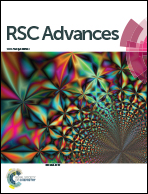Synthesis of Cu–Zn–Zr–Al–O catalysts via a citrate complex route modified by different solvents and their dehydrogenation/hydrogenation performance†
Abstract
The quaternary Cu–Zn–Zr–Al–O catalysts have been prepared by a citrate-complex method using deionized water, ethanol, and ethyl acetate as solvents. The solvents with different polarity and solubility have a prominent influence on the reaction pathway(s) of the synthesis. When using ethanol as solvent to prepare the catalysts, the selectivity and yield to ethyl acetate of 89.5 wt% and 70.6 wt%, respectively, corresponding to 78.9 wt% conversion of ethanol, are achieved. This catalyst also shows good catalytic activity and stability (>120 h at 220 °C) in the conversion of ethanol containing 7 wt% of water. Its remarkable performance is due to the existence of smaller CuO particles and their more uniform dispersion, which is beneficial to form Cu–MxOy (M = Zn, Zr, Al) interfaces. The catalyst showing more strong basic sites associated with the high density of O2− that migrated from the interaction of Cu–MxOy, which is favorable for the dehydrogenative dimerization of ethanol to ethyl acetate; furthermore, the moderate chemisorption and desorption of H2 makes this catalyst more favorable for ethanol dehydrogenation. This catalyst also proves to be effective for a series of ethyl ester hydrogenations (e.g., ethyl acetate and diethyl oxalate), indicating a general promotion of these reactions using ethanol as the solvent to prepare the catalysts.


 Please wait while we load your content...
Please wait while we load your content...